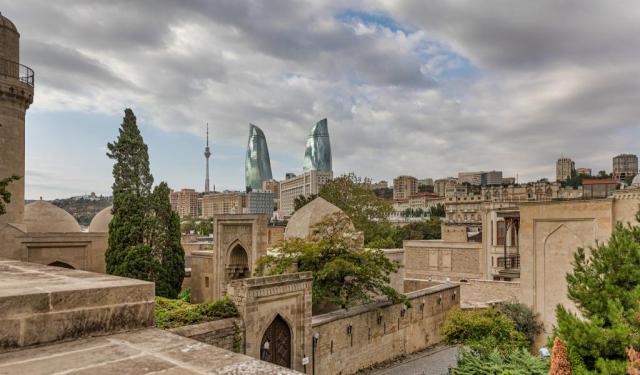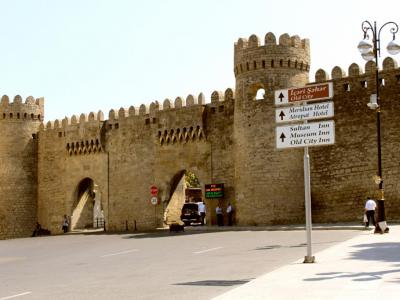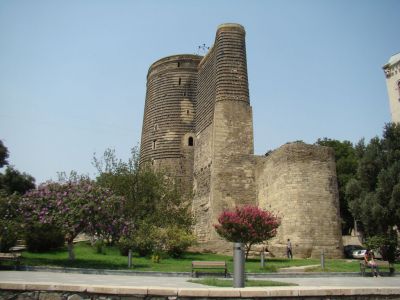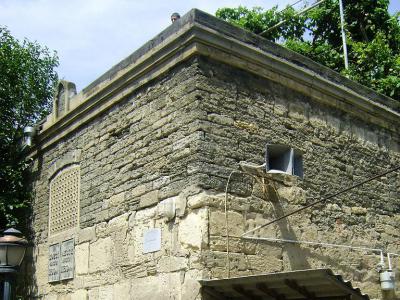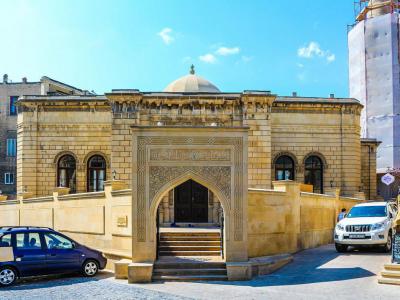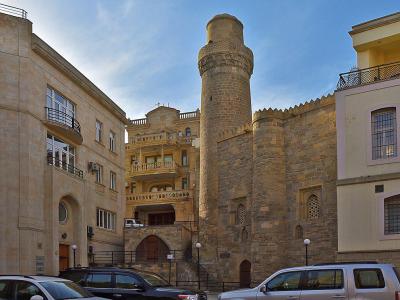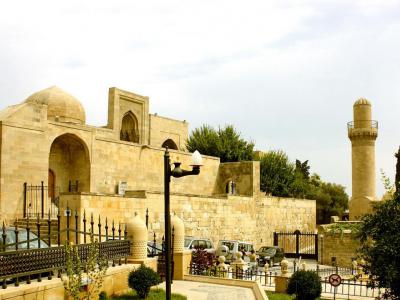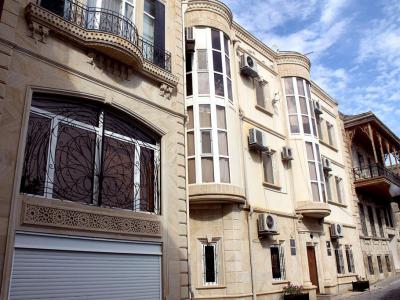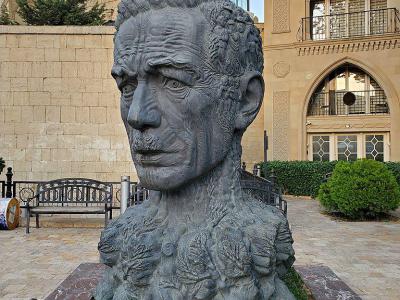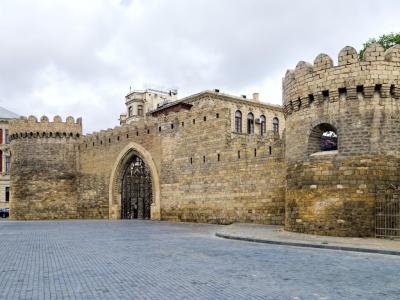Baku Old City Walking Tour (Self Guided), Baku
Baku's "Ichari Shahar" [pronounced ee-char-EE sha-HAR], which literally means Inner City, is also often referred to by foreigners as the Old City. This unique architectural preserve differs considerably from other ancient places in Azerbaijan and is replete with fascinating architectural monuments. The most prominent of them are the 12th-century, 97-foot Maiden Tower (the most distinctive symbol of the country, featured on national emblems and currency) and the Shirvanshah Palace, a 15th-century marvel described by UNESCO as "one of the pearls of Azerbaijan's architecture".
It is undoubtedly for this reason that in 2000 the Old City of Baku became the first location in Azerbaijan to be classified as a UNESCO World Heritage Site. The historical core of the capital is also its most ancient. Throughout centuries, it has developed its own distinct culture and set of traditions.
Back in the old days, entering the city was possible via two gates: the Salyan Gate and the Shemakha (or Shamakhi) Gate, a paired entry located in the northern wall of the Baku Fortress. The Fortress Wall itself, built in the 1130s, is an attraction in its own right.
Historically, the Old City was divided into several quarters, which also served as social divisions. Sometimes, these divisions were named after their mosque, such as, for instance, Juma Mosque quarter or Mahammad[yar] Mosque quarter. Behind the Juma Mosque, for a long time, an explicit symbol of the city, a mulberry tree, was located.
Other sections within the Inner City, including their mosques, were named after the clans and ethnic groups that resided there. One such is the Lezgi Mosque in Lezgiler street where the Dagestani armorers and gunsmiths used to live.
Among the more modern attractions within the Old City is the Museum of Miniature Books, the only one of its kind in the world.
To acquaint yourself more closely with the ancient part of the Azerbaijani capital, take this self-guided walking tour.
It is undoubtedly for this reason that in 2000 the Old City of Baku became the first location in Azerbaijan to be classified as a UNESCO World Heritage Site. The historical core of the capital is also its most ancient. Throughout centuries, it has developed its own distinct culture and set of traditions.
Back in the old days, entering the city was possible via two gates: the Salyan Gate and the Shemakha (or Shamakhi) Gate, a paired entry located in the northern wall of the Baku Fortress. The Fortress Wall itself, built in the 1130s, is an attraction in its own right.
Historically, the Old City was divided into several quarters, which also served as social divisions. Sometimes, these divisions were named after their mosque, such as, for instance, Juma Mosque quarter or Mahammad[yar] Mosque quarter. Behind the Juma Mosque, for a long time, an explicit symbol of the city, a mulberry tree, was located.
Other sections within the Inner City, including their mosques, were named after the clans and ethnic groups that resided there. One such is the Lezgi Mosque in Lezgiler street where the Dagestani armorers and gunsmiths used to live.
Among the more modern attractions within the Old City is the Museum of Miniature Books, the only one of its kind in the world.
To acquaint yourself more closely with the ancient part of the Azerbaijani capital, take this self-guided walking tour.
How it works: Download the app "GPSmyCity: Walks in 1K+ Cities" from Apple App Store or Google Play Store to your mobile phone or tablet. The app turns your mobile device into a personal tour guide and its built-in GPS navigation functions guide you from one tour stop to next. The app works offline, so no data plan is needed when traveling abroad.
Baku Old City Walking Tour Map
Guide Name: Baku Old City Walking Tour
Guide Location: Azerbaijan » Baku (See other walking tours in Baku)
Guide Type: Self-guided Walking Tour (Sightseeing)
# of Attractions: 9
Tour Duration: 1 Hour(s)
Travel Distance: 1.0 Km or 0.6 Miles
Author: ellen
Sight(s) Featured in This Guide:
Guide Location: Azerbaijan » Baku (See other walking tours in Baku)
Guide Type: Self-guided Walking Tour (Sightseeing)
# of Attractions: 9
Tour Duration: 1 Hour(s)
Travel Distance: 1.0 Km or 0.6 Miles
Author: ellen
Sight(s) Featured in This Guide:
- Paired Fortress Gates
- Maiden Tower
- Lezgi Mosque
- Juma Mosque (Cuma)
- Muhammad Mosque
- Shirvanshahs Palace
- Museum of Miniature Books
- Vahid Monument
- Baku Fortress Wall
1) Paired Fortress Gates
The Paired Fortress Gates of Baku, also known as the Gates of Shah Abbas or the Shamakhi Gates, are a historic architectural marvel in Azerbaijan. Situated in the northern wall of the ancient Baku Fortress, these gates serve as a testament to the city's rich history and strategic importance. Originating from the ancient caravan route from Shamakhi, these gates have been a key entry point to the fortress.
Construction of the first gate commenced in the 12th century, ordered by Manuchohr III during the initial phases of the fortress's construction. The second gate, known as the Gates of Zulfugar Khan, was added in the 17th century under the reign of Shah I Abbas by Zulfugar Khan. Remarkably, despite being constructed centuries apart, both gates share nearly identical dimensions and designs, reflecting the consistent architectural style maintained over the periods.
The gates were fortified with embrasures and battlements to protect against enemy attacks, demonstrating their strategic military importance. In 1796, a pivotal moment in their history occurred when Baku Khan Huseyngulu surrendered the fortress keys to the Russians. Subsequently, in 1883, the Gates of Zulfugar were moved to align with the Shamakhi Gate, completing the pairing in 1886.
Until the late 19th century, these gates remained the sole entrance and exit to the fortress. They have undergone several restoration phases: in 1864, during Soviet rule from 1952 to 1957, and most recently from 2018 to 2019, ensuring their preservation and continued prominence as a historical site.
Today, the Paired Fortress Gates are a major tourist attraction in Baku. Located adjacent to a tourist information center, they are part of a lively area, with a section of the adjacent wall often featuring artistic murals. The vicinity thrives with commercial activity, hosting a row of shops by day and numerous restaurants, enriching the cultural experience for visitors.
Construction of the first gate commenced in the 12th century, ordered by Manuchohr III during the initial phases of the fortress's construction. The second gate, known as the Gates of Zulfugar Khan, was added in the 17th century under the reign of Shah I Abbas by Zulfugar Khan. Remarkably, despite being constructed centuries apart, both gates share nearly identical dimensions and designs, reflecting the consistent architectural style maintained over the periods.
The gates were fortified with embrasures and battlements to protect against enemy attacks, demonstrating their strategic military importance. In 1796, a pivotal moment in their history occurred when Baku Khan Huseyngulu surrendered the fortress keys to the Russians. Subsequently, in 1883, the Gates of Zulfugar were moved to align with the Shamakhi Gate, completing the pairing in 1886.
Until the late 19th century, these gates remained the sole entrance and exit to the fortress. They have undergone several restoration phases: in 1864, during Soviet rule from 1952 to 1957, and most recently from 2018 to 2019, ensuring their preservation and continued prominence as a historical site.
Today, the Paired Fortress Gates are a major tourist attraction in Baku. Located adjacent to a tourist information center, they are part of a lively area, with a section of the adjacent wall often featuring artistic murals. The vicinity thrives with commercial activity, hosting a row of shops by day and numerous restaurants, enriching the cultural experience for visitors.
2) Maiden Tower (must see)
Maiden Tower is a tower in the Old City section of Baku. The 97-foot tower was completed in the 12th century. The tower is one of the most distinctive symbols of Azerbaijan and is featured on national emblems, letterheads and currency.
Archaeological and architectural evidence shows that the tower is an example of pre-Islamic architecture. It is believed that the Maiden Tower once had seven fire exits at its top, which would indicate it to be a Zoroastrian fire temple. Zoroastrianism is the ancient religion of Iran.
The foundation of the tower is much older than the tower itself. The underground foundation and the first three stories were built sometime between the 4th and 6th centuries. This also supports the idea that the tower was a Zoroastrian temple.
It is believed that the construction of the tower in the 12th century. It is also thought that the tower was then used as an astronomical observatory.
Maiden Tower was designated as a UNESCO World Heritage Site in 2000. Not long after this designation, an earthquake caused damage to the tower. Conservation efforts went into place to ensure the Maiden Tower remained structurally sound. A restoration plan was completed in 2013 in which the damaged sections were restored and plexiglass barriers were added to the observation deck.
Inside Maiden Tower is a museum that shows the history of Baku. Visitors can go to the observation deck to see a view of the city and Baku Bay.
Archaeological and architectural evidence shows that the tower is an example of pre-Islamic architecture. It is believed that the Maiden Tower once had seven fire exits at its top, which would indicate it to be a Zoroastrian fire temple. Zoroastrianism is the ancient religion of Iran.
The foundation of the tower is much older than the tower itself. The underground foundation and the first three stories were built sometime between the 4th and 6th centuries. This also supports the idea that the tower was a Zoroastrian temple.
It is believed that the construction of the tower in the 12th century. It is also thought that the tower was then used as an astronomical observatory.
Maiden Tower was designated as a UNESCO World Heritage Site in 2000. Not long after this designation, an earthquake caused damage to the tower. Conservation efforts went into place to ensure the Maiden Tower remained structurally sound. A restoration plan was completed in 2013 in which the damaged sections were restored and plexiglass barriers were added to the observation deck.
Inside Maiden Tower is a museum that shows the history of Baku. Visitors can go to the observation deck to see a view of the city and Baku Bay.
3) Lezgi Mosque
Lezgi Mosque, sometimes referred to as Ashur Mosque, is a 12th century mosque located in the Old City of Baku. The mosque was established in 1169.
Lezgi Mosque gets its name from the oil boom of the 19th century. Laborers flocked to Baku to work in the area. Lezgin workers from northeastern Azerbaijan used the mosque for their religious ceremonies, which led to the colloquial use of the name.
The mosque is shaped as a parallelepiped. It has a small entrance that leads to a prayer room. There are two small windows on one side of the building. Visitors may not enter the interior of the mosque as it is permanently closed, but the image from the street shows a building with a great deal of history.
Its unassuming nature hid the two semicircular arches that were hidden below the building. These arches were uncovered during restoration work took place in 1970. They show that the structure was built upon the foundation of a building that was much older.
Lezgi Mosque gets its name from the oil boom of the 19th century. Laborers flocked to Baku to work in the area. Lezgin workers from northeastern Azerbaijan used the mosque for their religious ceremonies, which led to the colloquial use of the name.
The mosque is shaped as a parallelepiped. It has a small entrance that leads to a prayer room. There are two small windows on one side of the building. Visitors may not enter the interior of the mosque as it is permanently closed, but the image from the street shows a building with a great deal of history.
Its unassuming nature hid the two semicircular arches that were hidden below the building. These arches were uncovered during restoration work took place in 1970. They show that the structure was built upon the foundation of a building that was much older.
4) Juma Mosque (Cuma)
Juma Mosque is a mosque that was completed in Baku in 1899. The mosque was built with financing from philanthropist Haji Shikhlali Dadashov.
The history of the mosque is much older than the one that presently stands. A mosque on the site called the Jame Mosque was built in the 12th century. It was built in the style of mosques from the Seljuk period. The dome was done in the style of the Maragha-Nakhchivan architectural school.
There are some records of the earlier mosque on the walls of Juma Mosque itself. One is an inscription showing the restoration of a mosque in 1309 and the other is a balcony that was erected in 1437. There are also traces of a Zoroastrian temple that predates the mosque.
During communist time, the mosque was turned into the home of the State Carpet Museum. It resumed use as a mosque in the 1990s after the collapse of the Soviet Union. A complete restoration took place in 2008, which added both heating and lighting.
The history of the mosque is much older than the one that presently stands. A mosque on the site called the Jame Mosque was built in the 12th century. It was built in the style of mosques from the Seljuk period. The dome was done in the style of the Maragha-Nakhchivan architectural school.
There are some records of the earlier mosque on the walls of Juma Mosque itself. One is an inscription showing the restoration of a mosque in 1309 and the other is a balcony that was erected in 1437. There are also traces of a Zoroastrian temple that predates the mosque.
During communist time, the mosque was turned into the home of the State Carpet Museum. It resumed use as a mosque in the 1990s after the collapse of the Soviet Union. A complete restoration took place in 2008, which added both heating and lighting.
5) Muhammad Mosque
Muhammad Mosque is a mosque that was established in the 11th century. According to an inscription on the wall of the mosque, it was built by ustad-rais Muhammad the son of Abu Bakr in 1079. It was the first building in Azerbaijan that used Islamic architecture.
The mosque is also known as Siniggala Mosque, which means "damaged tower." The minaret was damaged when the Russians bombed Baku in 1723. The minaret remained damaged through the 19th century.
The rebuilt minaret was constructed to resemble the older version as closely as possible. A set of narrow, winding stairs are located inside the trunk of the minaret though visitors are not allowed inside in order to preserve the space.
Muhammad Mosque is located in the Inner City, directly behind the Swiss Embassy. The narrow streets of Baku's Inner City allow visitors to have an excellent, up close view of the mosque and its minaret.
The mosque is also known as Siniggala Mosque, which means "damaged tower." The minaret was damaged when the Russians bombed Baku in 1723. The minaret remained damaged through the 19th century.
The rebuilt minaret was constructed to resemble the older version as closely as possible. A set of narrow, winding stairs are located inside the trunk of the minaret though visitors are not allowed inside in order to preserve the space.
Muhammad Mosque is located in the Inner City, directly behind the Swiss Embassy. The narrow streets of Baku's Inner City allow visitors to have an excellent, up close view of the mosque and its minaret.
6) Shirvanshahs Palace
Shirvanshahs Palace is a 15th-century palace in Baku's Inner City. The palace complex includes the main building, the burial vaults, the shah's mosque, a mausoleum, a gate, a reservoir and the ruins of a bath house and an ancient mosque.
The palace was built under the orders of Shirvan Khalil I in 1435. Inscriptions on his tomb and the mosque minaret show that the palace was completed sometime between 1436 and 1442. It is believed that the construction was based on the designs of the Shirvan-Absheron architectural school.
The palace was once surrounded by a wall with towers. It also once had rooms for court servants. Though none of the walls or service areas remain, remnants of the construction have been uncovered by archaeologists.
Shirvanshahs Palace was declared a museum-preserve in 1964. Restoration work on the palace began in 1992. In 2000, the palace was named a UNESCO World Heritage Site. Along with Maiden Tower, the palace was the first area in Azerbaijan to hold the World Heritage Site distinction.
The palace was built under the orders of Shirvan Khalil I in 1435. Inscriptions on his tomb and the mosque minaret show that the palace was completed sometime between 1436 and 1442. It is believed that the construction was based on the designs of the Shirvan-Absheron architectural school.
The palace was once surrounded by a wall with towers. It also once had rooms for court servants. Though none of the walls or service areas remain, remnants of the construction have been uncovered by archaeologists.
Shirvanshahs Palace was declared a museum-preserve in 1964. Restoration work on the palace began in 1992. In 2000, the palace was named a UNESCO World Heritage Site. Along with Maiden Tower, the palace was the first area in Azerbaijan to hold the World Heritage Site distinction.
7) Museum of Miniature Books
The Baku Museum of Miniature Books is a book museum with over 5,000 miniature books. It is the only museum of miniature books in the world. It also holds a Guinness World Record for being the world's largest private museum of miniature books.
It was established in 2002 by book lover and collector Zarifa Salahova. The exhibits come from Salahova's private collection that was amassed over the course of 30 years. The books come from 64 different countries with the majority being published in post-revolutionary Russia.
The museum holds rare editions of books from authors like Dostoyevsky, Pushkin and Gogol. There is also a 13th-century book published by Peter Schoffer and a copy of the Quran on display.
The three smallest books in the world are held in the Baku Museum of Miniature Books. "The Language of Flowers," "Birthstone," and "The Signs of the Zodiac" were published in Tokyo in 1978 by Toppan Publishing House. The books are so small that they can only be read with a magnifying glass.
The purpose of the museum, other than to showcase the miniature books, is to promote childhood literacy.
It was established in 2002 by book lover and collector Zarifa Salahova. The exhibits come from Salahova's private collection that was amassed over the course of 30 years. The books come from 64 different countries with the majority being published in post-revolutionary Russia.
The museum holds rare editions of books from authors like Dostoyevsky, Pushkin and Gogol. There is also a 13th-century book published by Peter Schoffer and a copy of the Quran on display.
The three smallest books in the world are held in the Baku Museum of Miniature Books. "The Language of Flowers," "Birthstone," and "The Signs of the Zodiac" were published in Tokyo in 1978 by Toppan Publishing House. The books are so small that they can only be read with a magnifying glass.
The purpose of the museum, other than to showcase the miniature books, is to promote childhood literacy.
8) Vahid Monument
The Aliagha Vahid Monument is a bronze memorial dedicated to poet and singer Aliagha Vahid. It was designed by Rahib Hasanov Natiq Aliyev in 1990.
Aliagha Vahid was born in a family of a carpenter and worked helped his father in his early years. In his early satirical poems he criticized social deficiencies in the society, superstition and narrow-mindedness, tyranny and unfairness. Later, he began to write ghazals. Vahid was known for reintroducing medieval ghazal style in Soviet Azerbaijani poetry.
The monument was inspired by a line of verse from the poet himself. It uses tree trunks and tree portraits to show the traditional Fuzuli nature revealed in Vahid's line, "I am the successor of great Fuzuli." The monument itself has the appearance of a large head growing from the tree stumps out of the ground.
The bronze work was done in Saint Petersburg. It was originally supposed to be 16-feet high but was reduced to just under 10 due to financial constraints.
The monument is located in the historic city center. A square, also dedicated to the poet, has ample seating and shade trees for those who wish to take their time to admire the artwork.
Aliagha Vahid was born in a family of a carpenter and worked helped his father in his early years. In his early satirical poems he criticized social deficiencies in the society, superstition and narrow-mindedness, tyranny and unfairness. Later, he began to write ghazals. Vahid was known for reintroducing medieval ghazal style in Soviet Azerbaijani poetry.
The monument was inspired by a line of verse from the poet himself. It uses tree trunks and tree portraits to show the traditional Fuzuli nature revealed in Vahid's line, "I am the successor of great Fuzuli." The monument itself has the appearance of a large head growing from the tree stumps out of the ground.
The bronze work was done in Saint Petersburg. It was originally supposed to be 16-feet high but was reduced to just under 10 due to financial constraints.
The monument is located in the historic city center. A square, also dedicated to the poet, has ample seating and shade trees for those who wish to take their time to admire the artwork.
9) Baku Fortress Wall
Baku Fortress Wall is part of the Baku Fortress complex. It was built around 1139 on the orders of the nineteenth independent Shah of Shirvan Shirvanshah Manuchohr III.
A second set of fortress walls were built under Shirvanshah Akhistan I. These walls were destroyed while the country was under Russian control in 1888. Baku Fortress Wall is now the only one that remains.
In 1910, Colonel P.I. Martynov, then mayor of Baku, ordered that no more components of the fortress could be destroyed. The law stated that the fortress wall should be salvaged and repaired in order to preserve history and keep residents safe from any pieces that may fall from the complex.
The wall and the remainder of the Baku Fortress complex was named a UNESCO World Cultural Heritage Site in 2000. Other components of the Baku Fortress complex include the entirety of the Icheri Sheher, or Old City, and the towers that surround the fort.
A second set of fortress walls were built under Shirvanshah Akhistan I. These walls were destroyed while the country was under Russian control in 1888. Baku Fortress Wall is now the only one that remains.
In 1910, Colonel P.I. Martynov, then mayor of Baku, ordered that no more components of the fortress could be destroyed. The law stated that the fortress wall should be salvaged and repaired in order to preserve history and keep residents safe from any pieces that may fall from the complex.
The wall and the remainder of the Baku Fortress complex was named a UNESCO World Cultural Heritage Site in 2000. Other components of the Baku Fortress complex include the entirety of the Icheri Sheher, or Old City, and the towers that surround the fort.
Walking Tours in Baku, Azerbaijan
Create Your Own Walk in Baku
Creating your own self-guided walk in Baku is easy and fun. Choose the city attractions that you want to see and a walk route map will be created just for you. You can even set your hotel as the start point of the walk.
Baku's Architectural Jewels
The city of Baku is an architectural marvel that delights with its historic buildings, grand mansions and cultural diversity. The Old City, for example, is full of fantastic old mosques and palaces that are listed as heritage monuments by UNESCO. The city is especially beautiful at night when it is wonderfully illuminated. Follow this self-guided walking tour to see the most impressive... view more
Tour Duration: 2 Hour(s)
Travel Distance: 3.8 Km or 2.4 Miles
Tour Duration: 2 Hour(s)
Travel Distance: 3.8 Km or 2.4 Miles
Baku Introduction Walking Tour
Baku is the capital city of Azerbaijan. It is also the country's largest city with about 25 percent of the nation's population located here.
A city existed on the site of Baku since at least the 5th century ADE. The city at that time was called Bagavan. The first record of its modern name appeared in 938 when it was called Bakuh. The city was a domain of the Arab Caliphate, followed... view more
Tour Duration: 2 Hour(s)
Travel Distance: 4.1 Km or 2.5 Miles
A city existed on the site of Baku since at least the 5th century ADE. The city at that time was called Bagavan. The first record of its modern name appeared in 938 when it was called Bakuh. The city was a domain of the Arab Caliphate, followed... view more
Tour Duration: 2 Hour(s)
Travel Distance: 4.1 Km or 2.5 Miles
The Most Popular Cities
/ view all
